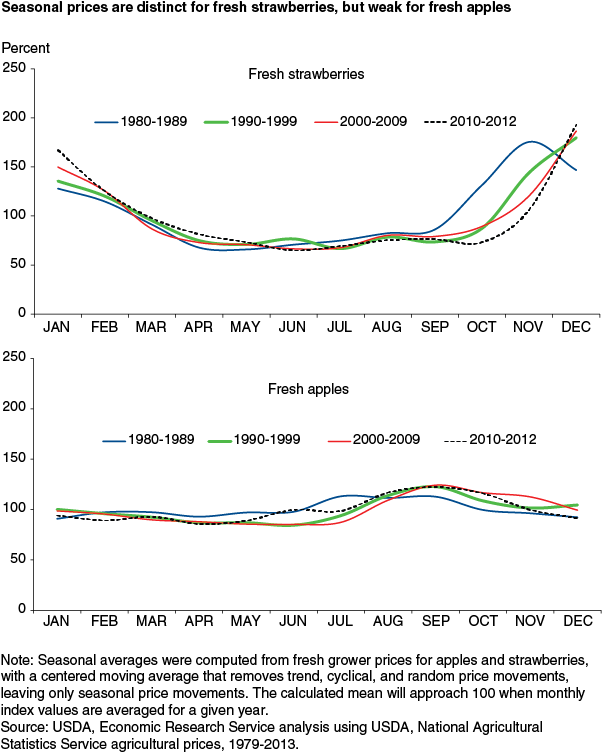Seasonal Fresh Fruit Price Patterns Differ Across Commodities: The Case of Strawberries and Apples
- by Kristy Plattner, Agnes Perez and Suzanne Thornsbury
- 10/6/2014
Fresh produce prices are subject to seasonal patterns, the result of uneven demand, supply, or movement to market, when either production and/or use is concentrated during particular months. Over the past 30 years, produce markets have seen changes in imports, production, storage, and demand that may have caused shifts in seasonal price patterns. To investigate this issue, ERS researchers created a grower price index to separate seasonal price effects from other components of price variability, such as trend, cyclical, and random movements. Researchers found that the effects from each of these change drivers vary over time and between markets, the result of unique commodity and market conditions. These differences are illustrated in a comparison of fresh strawberry and apple markets; results show a persistence of seasonality in strawberry prices, but some smoothing of apple price fluctuations over time.
Fresh strawberry prices still show a distinct seasonal pattern, despite the expanded geographical and varietal diversity that has smoothed seasonal price effects (particularly since 2000). In most years, strawberry grower prices tend to decrease through the first four months of the year, stabilize at low levels from May through August when supply volumes are at their peak, and rise from September to December. While increasing imports have helped bolster year-round availability of fresh strawberries in the United States, they remain a small, albeit growing, part of U.S. fresh strawberry use, with volume concentrated in the winter and early spring.
In contrast to the strawberry market, changes in the fresh apple industry and markets since the 1980s have mitigated seasonal price fluctuations. Fresh U.S. apple production has grown 30 percent since 1980, and the industry has introduced new varieties and retail products, such as fresh sliced apples. New varieties with later harvest dates, along with more sophisticated storage technology, have extended the marketing season. Imports play a minor, though growing, role in U.S. fresh apple use and remain largely counter-seasonal to domestic production. Increased exports and a growing market for processed apples have helped absorb the increased availability from domestic production and imports since the 1980s. For these reasons, fresh apples exhibit fairly weak seasonal grower price patterns. U.S. apples are typically harvested between August and November, but the ability to store apples for a long period allows an even, sustained release of supplies to market that helps mitigate seasonal price variability.
In summary, market conditions unique to each commodity influence the impacts of changing supply and demand factors on the seasonality of grower prices. Over time, fresh fruit suppliers have extended the period these fruits are available in the U.S. market through imports, increased domestic output, expanded planting regions, and/or enhanced storage. In addition, global demand for U.S. products and, in some cases, growth in alternative markets for processing have influenced timing of sales.
This article is drawn from:
- Plattner, K., Perez, A. & Thornsbury, S. (2014). Evolving U.S. Fruit Markets and Seasonal Grower Price Patterns. U.S. Department of Agriculture, Economic Research Service. FTS-357-01.



